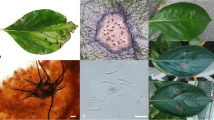Abstract
A new defoliating disease with severe leaf spot of Japanese persimmon (Diospyros kaki) was found in Shimane Prefecture. A fungus, isolated from the ascospores that had formed on the leaf spot, was demonstrated to reproduce the symptoms on leaves and described as a new species, Adisciso kaki, based on morphological and molecular phylogenetic analyses. This fungus is characterized by small ascomata without clypeus, obclavate to broadly cylindrical asci with an amyloid apical apparatus, and hyaline ascospores with a submedian septum. We coined the name black leaf spot (Kurohoshi-rakuyo-byo, in Japanese) for the new disease.



Similar content being viewed by others
References
Anonymous (2012) Common names of plant diseases in Japan, 2nd edn. (in Japanese). Phytopathological Society of Japan and National Institute of Agrobiological Sciences, Tokyo (in press)
Brockmann I (1976) Untersuchungen über die Gattung Discostroma Clements (Ascomycetes) (in German). Sydowia 28:275–338
Farr DF, Bills GF, Chamuris GP, Rossman AY (1989) Diospyros L. In: Farr DF, Billis FG, Chamuris GP, Rossman AY (eds) Fungi on plants and plant products in the United States. APS Press, St. Paul, pp 167–168
Fujinaga M, Yamagishi N, Ogiso H, Takeuchi J, Moriwaki J, Sato T (2011) First report of celery stunt anthracnose caused by Colletotrichum simmondsii in Japan. J Gen Plant Pathol 77:243–247
Kitajima H (1989) Detailed review of fruit tree diseases (in Japanese). Yokendo, Tokyo, pp 463–471
Okane I, Nakagiri A, Ito T (1996) Discostroma tricellulare, a new endophytic ascomycete with a Seimatosporium anamorph isolated from Rhododendron. Can J Bot 74:1338–1344
Paulus BC, Gadek PA, Hyde KD (2006) Discostroma ficicola sp. nov. (Amphisphaeriaceae) and a key to species of Discostroma. Sydowia 58:76–90
Shoemaker RA (1984) Canadian and some extralimital Nodulosphaeria and Entodesmium species. Can J Bot 62:2730–2753
Sivanesan A, Shivas RG (2002) New species of foliicolous Loculoascomycetes on Dysoxylum, Melaleuca and Syzygium from Queensland, Australia. Fungal Divers 11:151–158
Smith IM, Dunez J, Lelliot RA, Phillips DH, Archer SA (1988) European handbook of plant diseases. Blackwell, Oxford, pp 262–263
Tamura K, Peterson D, Peterson N, Stecher G, Nei M, Kumar S (2011) MEGA5: molecular evolutionary genetics analysis using maximum likelihood, evolutionary distance, and maximum parsimony methods. Mol Biol Evol 28:2731–2739
Tanaka K, Harada Y (2003) Pleosporales in Japan (1): the genus Lophiostoma. Mycoscience 44:85–96
Tanaka K, Endo M, Hirayama K, Okane I, Hosoya T, Sato T (2011) Phylogeny of Discosia and Seimatosporium, and introduction of Adisciso and Immersidiscosia genera nova. Persoonia 26:85–98
White TJ, Bruns T, Lee S, Taylor J (1990) Amplification and direct sequencing of fungal ribosomal RNA genes for phylogenetics. In: Innis MA, Gelfand DH, Sninsky JJ, White TJ (eds) PCR protocols: a guide to methods and applications. Academic Press, San Diego, pp 315–322
Yamamoto J, Ohtaka N, Sato T (2009) Black leaf spot of Japanese persimmon caused by Discostroma sp. (abstract in Japanese). Jpn J Phytopathol 75:234
Yamazaki T, Ogata T, Matsui H, Hotta M, Suzuki S, Nitta A, Iijima Y (1989) Diospyros L. In: Hotta M, Ogata K, Nitta A, Hoshikawa K, Yanagi M, Yamazaki K (eds) Useful plants of the world (in Japanese). Heibonsha Co., Tokyo, pp 386–389
Acknowledgments
We thank Dr. Takao Kobayashi, formerly of Tokyo University of Agriculture, for kindly supplying the fungal strain collected in Matsudo, Chiba Pref., Japan and to Dr. Yuuri Hirooka, Forestry and Forest Products Research Institute, Ibaraki, Japan, for assistance in fungal isolation.
Author information
Authors and Affiliations
Corresponding author
Rights and permissions
About this article
Cite this article
Yamamoto, J., Tanaka, K., Ohtaka, N. et al. Black leaf spot of Japanese persimmon (Diospyros kaki), a new disease caused by Adisciso kaki sp. nov.. J Gen Plant Pathol 78, 99–105 (2012). https://doi.org/10.1007/s10327-012-0367-9
Received:
Accepted:
Published:
Issue Date:
DOI: https://doi.org/10.1007/s10327-012-0367-9




